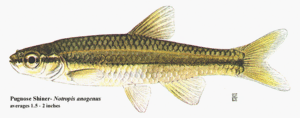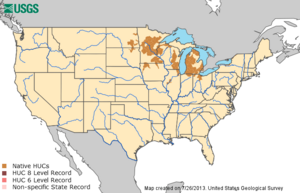Pugnose shiner facts for kids
Quick facts for kids Pugnose shiner |
|
|---|---|
 |
|
| Conservation status | |
| Scientific classification | |
| Synonyms | |
|
The pugnose shiner (Notropis anogenus) is a small, shiny fish. It belongs to the Notropis group. This fish is part of the Cyprinidae family, which includes freshwater carps and minnows. This family is huge, with thousands of different fish species!
Sadly, the number of pugnose shiners is going down. This is because people remove water plants to make swimming areas and boat paths. Today, you can mostly find them in Minnesota, Wisconsin, and Michigan.
Contents
Where Do Pugnose Shiners Live?
The pugnose shiner is not a very common fish. In the United States, it lives in parts of Minnesota, Wisconsin, and Michigan. This fish is native to North America. Long ago, it lived in many places. Its old home stretched from eastern Ontario and New York to North Dakota and Illinois. It also lived in Indiana, Ohio, and near the St. Lawrence River.
The pugnose shiners that once lived in North Dakota are now gone. This happened because the water became cloudy. Also, plants were pulled up from the lakes and streams. You can also find this minnow in a few areas of Canada. However, their numbers there have also dropped over time. Most Canadian pugnose shiners now live in Ontario.
What Does a Pugnose Shiner Look Like?
The pugnose shiner is a type of minnow. It can live for up to three years. These fish usually grow to be about 47 millimeters long. Some can be as small as 20mm or as big as 60mm. It has a dark stripe on its side. This stripe goes from its tail fin, through its eye, all the way to its nose.
Its mouth is small and points upwards. This gives it a "pug-nose" look. Its belly area is yellow, and its tail fin is clear. Each fish has about 34 to 37 round, silver scales. These scales cover its body. The body shape helps the pugnose shiner swim well in water currents. Its pelvic fins are located on its belly.
Like other ray-finned fish, its fins have bony rays. These rays help support the fins. The pugnose shiner has an 8-rayed dorsal fin on its back. This helps tell it apart from other minnows. It is also the only Notropis species in Minnesota with a dark lining inside its body cavity.
Pugnose Shiner's Environment and Diet
Even though it's not common, the pugnose shiner lives in clear, weedy lakes. It also likes slow-moving streams. These are found in cool, freshwater areas. When the weather is warm, you can find this fish in shallow water. But in winter, it moves to deeper water, up to 2 meters deep.
The pugnose shiner is a good sign of a healthy ecosystem. This is because it is very sensitive to its environment. It cannot live in cloudy water. Their diet usually includes stringy algae and tiny water fleas called cladocera. They also eat eggs, insects, worms, and other small things under 2mm.
Larger fish that eat both plants and animals will prey on the pugnose shiner. These shiners are mid to low-level consumers. This means they play a small part in moving nutrients through the food chain.
Pugnose Shiner Life Cycle and Reproduction
Pugnose shiners become ready to have babies when they are 1 or 2 years old. This is true for both males and females. They are an oviparous species. This means the females lay eggs. Spawning, or laying eggs, happens in summer, from May to July.
The female lays her eggs in shallow water. She chooses areas with lots of plants. She can lay between 530 and 1275 eggs. Once the eggs are fertilized, they usually hatch in one or two days. This fish species does not take care of its eggs or young. After the eggs are laid and fertilized, the parents leave them.
Male and female pugnose shiners look a bit different. This is called sexual dimorphism. For example, the males' pelvic fins are longer than the females'. They also have a mating system where both males and females have many different partners.
Pugnose Shiner Conservation Status
The conservation status of the pugnose shiner has changed a lot recently. Its status depends on where the fish population lives. In Canada, the pugnose shiner is currently listed as endangered. But in the United States, its status changes from state to state.
This species has been decreasing in the upper Midwest. This is due to cloudy water, fewer plants, and new species moving into their homes. There are many small groups of pugnose shiners. However, these groups don't connect much. This is because the fish don't travel far.
In 2010, it was listed as Near Threatened. But as of 2014, the pugnose shiner is listed as Least Concern. Still, its numbers are going down. So, it continues to need attention for its protection.
What Does "Pugnose Shiner" Mean?
The genus name for the pugnose shiner is Notropis. This name comes from Greek. It was given to fish that looked shriveled. It means "back keel". The species name anogenus also comes from Greek. It means "without a chin".



